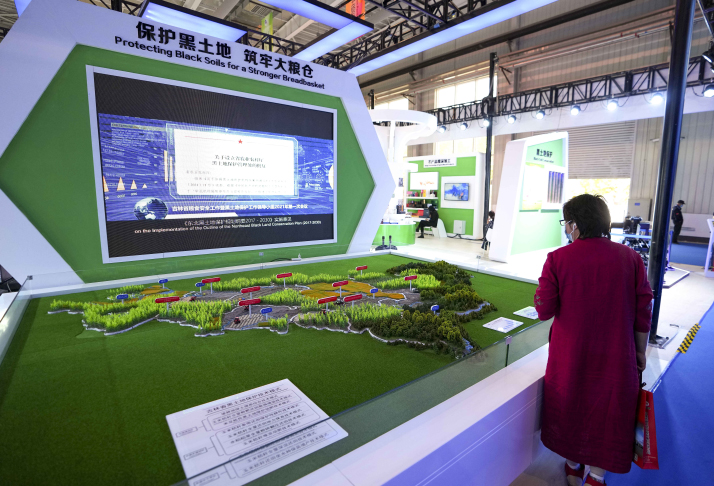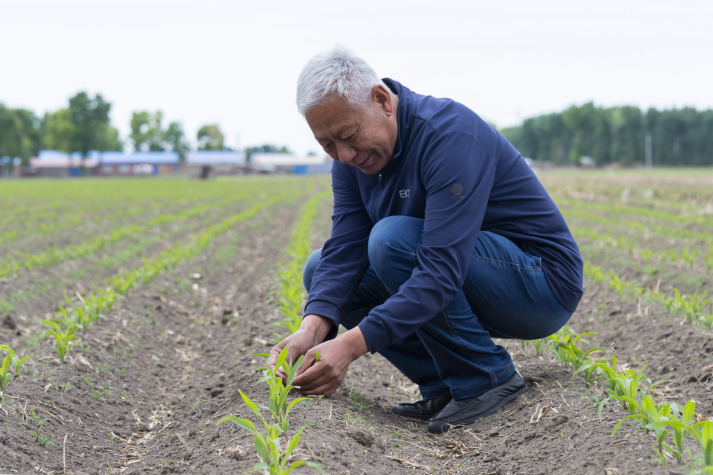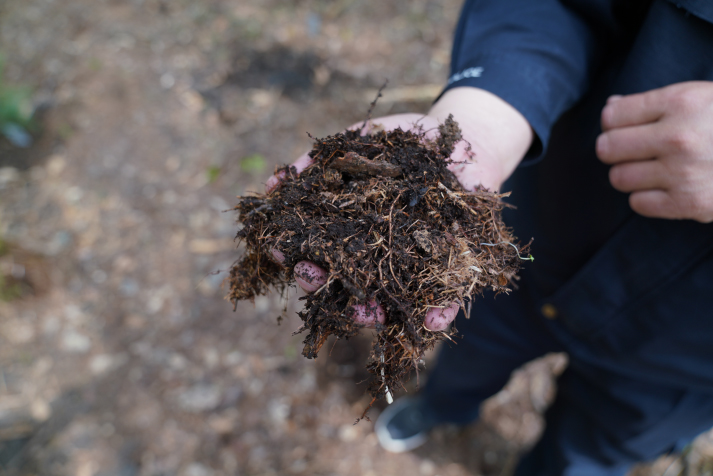| China |
| Soil protection gains momentum in northeast China | |
|
|
 A smart soil protection technology model on display at an exhibition in Changchun, Jilin Province, on September 24, 2021 (XINHUA)
Before daybreak on some mornings in May, Zhang Wendi frequently went to his fields to check if the corn he sowed had emerged from the ground. Zhang is chairperson of the Hongwang Agricultural Machinery Farmers Professional Cooperative in Lishu County, Jilin Province. Every year, he is overjoyed to see the new green seedlings emerge, bringing with them the promise of the harvest to come. His corn fields are part of Lishu's test plots for the conservative farming system the county adopted in 2007. Thanks to the large-scale application of new technologies and techniques, yields have increased and so has income. "More importantly, this model is a departure from traditional farming methods, and is aimed to protect the black soil in the best way possible," Wang Guiman, a local official in charge of promoting farming technology, told Jilin Daily. In June, China's top legislature passed a law on black soil conservation. It stipulates consistent government funding and targeted protection measures as part of efforts to ensure the country's grain security. The law will take effect on August 1.  A village official checks crop growth in Anle Village, Heilongjiang Province, on May 25 (XINHUA)
The 'giant panda' of land The black soil, or chernozem soil, found in China's northeastern provinces of Heilongjiang, Jilin and Liaoning and some parts of Inner Mongolia Autonomous Region, produces about one quarter of the country's total grain output, making it crucial to securing China's food basket. Northeast China is also a major area for maize and soybean farming. It takes 300 million years to form a 100-cm layer of black soil, according to Chen Wenfu, an academician of the Chinese Academy of Engineering. Chinese Vice Premier Hu Chunhua once described the soil as the "giant panda of cultivated land" that plays an irreplaceable role in ensuring China's food security, during an on-site inspection in the city of Suihua, Heilongjiang, in June 2021. Unfortunately, years of excessive reclamation, fertilizer overuse and ineffective management have caused degeneration of the black soil and eroded the soil's nutrients. The chernozem layer is now thinning out, posing a threat to the country's ecological security and sustainable agricultural development. Take Jilin's statistics as an example. Local monitoring data showed that the organic matter content of black soil in the province had dropped from 8 percent in the early 1950s to less than 2 percent in the recent decade. The new law says that government investment in black soil protection should be ensured, along with comprehensive protection measures in engineering, agronomic techniques, farming machinery and biology. The scope of the black soil protection area should be appropriately delimited and adjusted based on both its previous reclamation and current utilization, to better protect and restore the resource in systematic, phased and targeted manner, according to the law. Lishu's adoption of the model was an example of a national key grain output county successfully changing course to preserve its soils. "In the past, many farmers used the land without allowing it to recover and, in pursuit of high yields, crop rotation was rarely performed," Wang said, noting that as the economic value of corn is higher than that of soybeans, farmers chose to grow corn season after season, depleting much of the soil's fertility. Developed by the local agricultural department, the Chinese Academy of Sciences and China Agricultural University (CAU), the new model focuses on technical measures such as no-tillage seeding and returning crop stalks to the field to reduce soil disturbance, improve its structure, and increase fertility and water retention capacity. The measures also help limit the use of chemical fertilizers, save labor and maintain, or even increase, yields. When the measures were first introduced, some farmers had their doubts. "We wanted to keep the land fertile, too. We were hesitated because if it didn't work, one whole year of hard work would just go down the drain. But local officials assured us with a promise to compensate us if things didn't go well," Zhang said. "As we saw tangible results of high yields and more income, we become fans of these new techniques." In 2020, the country allocated 1.6 billion yuan ($238 million) to subsidize farmers for protecting the soil. As time goes by and techniques have improved, Lishu farmers have seen better and better results. In the past two years, the county's grain production has increased by about 8 percent, according to the local agricultural authority. Grain growers throughout China's northeast are also coming up with locality-specific methods of protecting their black soil. In June 2021, Heilongjiang introduced a regulation on the protection and utilization of black soil in the province, which has over 45 percent of China's black soil lands. Before that, the government revealed several cases relating to the abuse of Heilongjiang's soil. In one example, a criminal surnamed Wang rented agricultural land from farmers in multiple villages to dig peat, a non-renewable resource rich in organic matter, from beneath the layer of black soil. As a result, planting conditions of the rented farmland were severely damaged. In 2021, the criminal and his accomplices were punished with fines and terms of imprisonment. The black soil conservation law stipulates harsher punishment for those who cause soil erosion in black soil areas in accordance with relevant laws and regulations. The law also encourages farms to set a fine example in protection efforts and be subject to supervision and inspection. This year, all villages in Heilongjiang launched a system of division of responsibility. The system ensures that the soil is protected by a specific person in charge of supervising the condition of farmlands. They are also held accountable for maintaining the amount and quality of the black soil they supervise.  A handful of black soil in Yichun, Heilongjiang Province, on May 19 (XINHUA)
The smart way Intelligent technologies have given a push to black soil protection, while ensuring production remains high. In 2005, a hi-tech farm was set up in Jiamusi, Heilongjiang, where experts and agricultural students introduce advanced technology to local farmers. The platform is the joint effort of CAU, a subsidiary of the Beidahuang Group, a leading agricultural enterprise, and the local government. At the farm, intelligent operations have enabled unmanned seed germination, paddy preparation, seedling transplanting, fertilizer application and drone topdressing. In 2019, farmer Ru Ziyang joined the endeavor and his land became part of the farm. Since then, he has been using a smartphone application to check the soil moisture, air temperature, plant growth and other information of each plot. "Since the arrival of the CAU professors and students, we have abandoned our old-fashioned farming methods," Ru told China Youth Daily, adding that the biggest change is that the amount of fertilizer used has been reduced, while the land utilization rate has been improved. "Due to the COVID-19 pandemic, labor is in short supply, and the overall farming cost has been increasing year by year. The application and promotion of the intelligent navigation-assisted driving system saves manpower, reduces costs, and improves work efficiency for farmers transplanting rice," said Dong Chuanbao, a member of the farm's technology team. Fan Mingsheng, a professor at the CAU's College of Resources and Environment Sciences, records the progress of soil protection efforts. In 2021, the smart agriculture demonstration area covered 233 hectares, involving 11 farming households. The new management techniques have increased output by 7 percent and reduced the labor cost of applying fertilizers by half, reducing fertilizer consumption by a fifth, and helping farmers increase their income by more than 2,000 yuan ($298) per hectare. "Scientific and research institutes should conduct research to address the specific difficulties faced by farmers nationwide, so that they are more willing to use advanced technologies," Zhao Lixin, head of the Institute of Environment and Sustainable Development in Agriculture at the Chinese Academy of Agricultural Sciences, told Beijing Review. "Many farmers are still unwilling to innovate because they are used to the old techniques. They are afraid the new methods will be costly and troublesome. Governments and research organizations should help relieve them of such worries," Zhao said. (Print Edition Title: Black Gold) Copyedited by G.P. Wilson Comments to luyan@cicgamericas.com |
|
||||||||||||||||||||||||||||
|
